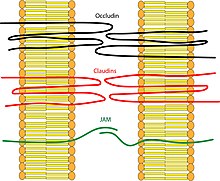

| Tight junction | |
|---|---|

Diagram of tight junction
| |
| Details | |
| Identifiers | |
| Latin | junctio occludens |
| MeSH | D019108 |
| TH | H1.00.01.1.02007 |
| FMA | 67397 |
| Anatomical terminology | |
Tight junctions, also known as occluding junctionsorzonulae occludentes (singular, zonula occludens), are multiprotein junctional complexes whose canonical function is to prevent leakage of solutes and water and seals between the epithelial cells.[1] They also play a critical role maintaining the structure and permeability of endothelial cells.[1] Tight junctions may also serve as leaky pathways by forming selective channels for small cations, anions, or water. The corresponding junctions that occur in invertebrates are septate junctions.
Tight junctions are composed of a branching network of sealing strands, each strand acting independently from the others. Therefore, the efficiency of the junction in preventing ion passage increases exponentially with the number of strands. Each strand is formed from a row of transmembrane proteins embedded in both plasma membranes, with extracellular domains joining one another directly. There are at least 40 different proteins composing the tight junctions.[2] These proteins consist of both transmembrane and cytoplasmic proteins. The three major transmembrane proteins are occludin, claudins, and junction adhesion molecule (JAM) proteins. These associate with different peripheral membrane proteins such as ZO-1 located on the intracellular side of plasma membrane, which anchor the strands to the actin component of the cytoskeleton.[3] In this way, tight junctions join together the cytoskeletons of adjacent cells. Investigation using freeze-fracture methods in electron microscopy is ideal for revealing the lateral extent of tight junctions in cell membranes and has been useful in showing how tight junctions are formed.[4]


Tight junctions provide endothelial and epithelial cells with barrier function, which can be further subdivided into protective barriers and functional barriers serving purposes such as material transport and maintenance of osmotic balance.[13]
Tight junctions prevent the passage of molecules and ions through the intercellular space of adjacent cells, so materials must actually enter the cells (bydiffusionoractive transport) in order to pass through the tissue. The constrained intracellular pathway exacted by the tight junction barrier system allows precise control over which substances can pass through a particular tissue (e.g. the blood–brain barrier). At the present time, it is still unclear whether the control is active or passive and how these pathways are formed. In one study for paracellular transport across the tight junction in kidney proximal tubule, a dual pathway model was proposed, consisting of large slit breaks formed by infrequent discontinuities in the tight junction complex and numerous small circular pores.[14]
Tight junctions also help maintain the apicobasal polarity of cells by preventing the lateral diffusion of integral membrane proteins between the apical and lateral/basal surfaces, allowing the specialized functions of each surface (for example receptor-mediated endocytosis at the apical surface and exocytosis at the basolateral surface) to be preserved. This allows polarized transcellular transport and specialized functions of apical and basolateral membranes.
Epithelia are classed as "tight" or "leaky", depending on the ability of the tight junctions to prevent water and solute movement:[15]
|
Proteins of epithelium
| |
|---|---|
| Lateral/cell–cell |
|
| Basal/cell–matrix |
|
| Apical |
|
| Authority control databases: National |
|
|---|